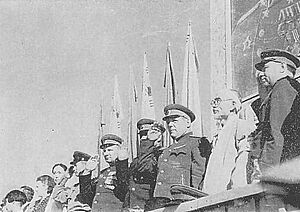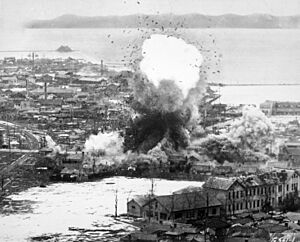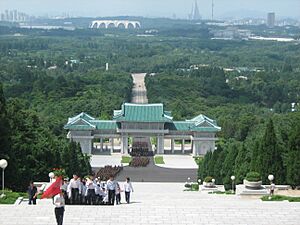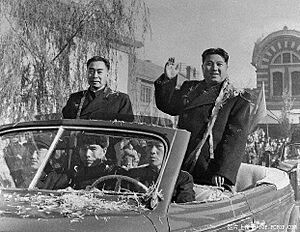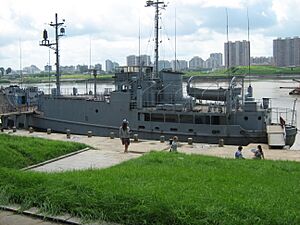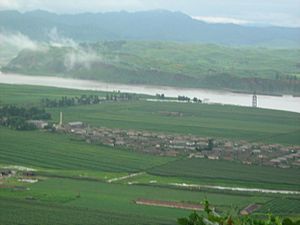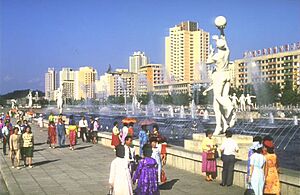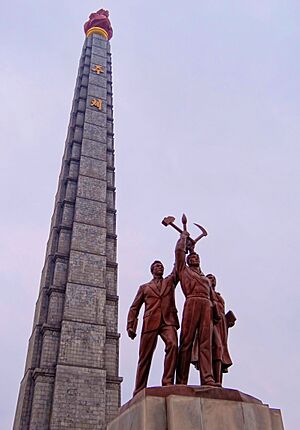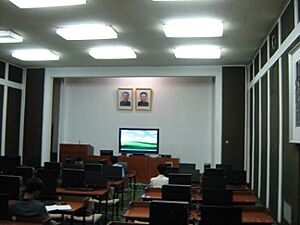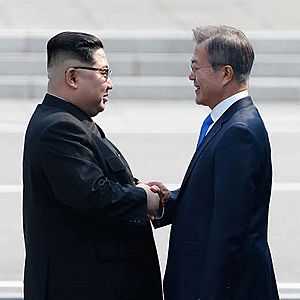History of North Korea facts for kids
The history of North Korea started after World War II ended in 1945. When Japan surrendered, Korea was split into two parts at the 38th parallel. The Soviet Union took control of the northern part, and the United States took the southern part. Because the two powerful countries couldn't agree on how to unite Korea, they set up two separate governments in 1948. The north became the Democratic People's Republic of Korea (DPRK), supported by the Soviets. The south became the Republic of Korea, supported by the Americans. Both claimed to be the true government of all Korea.
In 1950, the Korean War began. After a lot of fighting and destruction, the war ended in a stalemate, meaning no clear winner. The dividing line at the 38th parallel was replaced by the Korean Demilitarized Zone. Tensions between the two sides remained high. North Korea then worked hard to rebuild its economy, focusing on industry and government control.
Kim Il Sung was the leader of North Korea until he died in 1994. He created a strong "personality cult" around himself, meaning people were taught to admire and almost worship him. He also guided the country with the idea of Juche, which means "self-reliance." However, North Korea faced big problems like natural disasters and the end of the Soviet Union in 1991, which caused a severe economic crisis. Kim Il Sung's son, Kim Jong Il, became the next leader, and then his grandson, Kim Jong Un, took over after that.
Contents
Korea Before Division
From 1910 until the end of World War II in 1945, Korea was ruled by Japan. Most Koreans were farmers who grew just enough food for themselves. In the 1930s, Japan built many factories, mines, and power plants in northern Korea and nearby Manchuria. This led to a fast growth in the number of industrial workers. About 65% of Korea's heavy industry was in the north, but only 37% of its farmland was there.
Northern Korea didn't have much contact with modern Western ideas. One exception was Christianity. Since missionaries arrived in the late 1800s, the northwest of Korea, especially Pyongyang, became a strong Christian area. Pyongyang was even called the "Jerusalem of the East."
A group of Korean fighters, called guerrillas, fought against the Japanese rulers in the mountains and in Manchuria. One of the most famous guerrilla leaders was a Communist named Kim Il Sung.
Dividing Korea (1945–1950)
At meetings in 1943 and 1945, the Soviet Union promised to join its allies in the war against Japan within three months of victory in Europe. On August 8, 1945, the Soviet Union declared war on Japan. Soviet troops quickly moved into Korea. The US government worried they might take over all of Korea. So, on August 10, the US suggested dividing Korea at the 38th parallel. This line would put the capital city, Seoul, under American control. Surprisingly, the Soviet Union quickly agreed. This agreement was part of the plan for Japan's surrender. The division placed 16 million Koreans in the American zone and 9 million in the Soviet zone.
Soviet forces started landing in Korea by August 14 and quickly took over the northeast. By August 24, the Red Army reached Pyongyang. US forces didn't arrive in the south until September 8.
During August, local groups called People's Committees formed across Korea. These committees were linked to a group preparing for Korean independence, which later created the People's Republic of Korea. When Soviet troops entered Pyongyang, they found a local People's Committee led by a Christian nationalist named Cho Man-sik. Unlike the Americans, the Soviets worked with these committees. Some say Cho Man-sik was the Soviets' first choice to lead North Korea.
On September 19, Kim Il Sung and 66 other Korean Red Army officers arrived in Wonsan. They had fought the Japanese in Manchuria in the 1930s and had lived and trained in the USSR since 1941. On October 14, Soviet officials introduced Kim to the North Korean public as a war hero.
In December 1945, at a meeting in Moscow, the Soviet Union agreed to a US idea for Korea to be under a "trusteeship" for up to five years before becoming fully independent. Most Koreans wanted independence right away. But Kim and other Communists supported the trusteeship because the Soviet government pressured them. Cho Man-sik spoke against the idea and was put under house arrest. In February 1946, the People's Committees were reorganized and controlled by Communists. The new government brought in popular changes like giving land to poor farmers, making industries state-owned, reforming labor laws, and giving women equal rights.
Meanwhile, existing Communist groups joined together under Kim Il Sung's leadership. In August 1946, this party merged with another to form the Workers' Party of North Korea. In 1949, this party merged with its southern counterpart to become the Workers' Party of Korea, with Kim as its chairman.
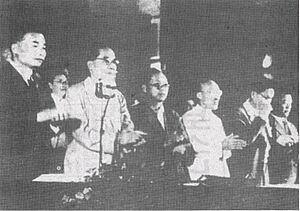
In 1946, a series of laws changed North Korea to be like the Soviet Union's Communist system. The "land to the tiller" reform gave most farmland to poor farmers, which broke the power of rich landowners. This was followed by laws about labor, equality for women, and making industries, transport, and banks state-owned.
Kim created the Korean People's Army (KPA), which was aligned with the Communists. It was made up of experienced fighters who had fought against the Japanese and Chinese troops. With help from Soviet advisors and equipment, Kim built a large army skilled in surprise attacks and guerrilla warfare. Before the Korean War, Joseph Stalin gave the KPA modern tanks, trucks, and weapons. Kim also formed an air force with Soviet planes. Later, North Korean pilots trained in the Soviet Union and China to fly jet planes.
North Korea is Formed
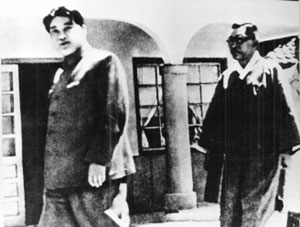
Since talks with the Soviet Union about Korea's future weren't working, the US took the issue to the United Nations in September 1947. The UN then set up a commission to hold elections in Korea. The Soviet Union didn't agree with this. So, it was decided to hold UN-supervised elections only in the south. In April 1948, a meeting of groups from both North and South Korea was held in Pyongyang, but it didn't achieve much. The southern politicians Kim Koo and Kim Kyu-sik attended but boycotted the elections in the South.
Elections were held in South Korea on May 10, 1948. On August 15, the Republic of Korea officially began. A similar process happened in North Korea. A new assembly was elected in August 1948, and a new constitution was announced on September 3. The Democratic People's Republic of Korea (DPRK) was officially started on September 9, with Kim Il Sung as its leader. On December 12, 1948, the United Nations said the Republic of Korea was the "only lawful government in Korea."
By 1949, North Korea was a full Communist state. All political groups joined the Democratic Front for the Reunification of the Fatherland. This group was supposed to be a broad alliance, but it was really controlled by the Communists. The government quickly set up a political system similar to the Soviet Union's, where the Workers' Party of Korea (WPK) held all the power.
Korean War (1950–1953)
The government in South Korea, led by Syngman Rhee and supported by the US military, became stronger. This ended North Korea's hope that a revolution in the South could unite Korea. So, from early 1949, Kim Il Sung asked the Soviet Union and China for help to invade the South and unite the country by force. Most US forces left South Korea in June 1949, leaving the South Korean army weak. The North Korean army, however, had good equipment from the Soviet Union and many experienced soldiers. In 1949 and 1950, Kim traveled to Moscow to get support for a war.
At first, Joseph Stalin said no to Kim Il Sung's requests to invade the South. But in late 1949, after the Communists won in China and the Soviets developed nuclear weapons, Stalin changed his mind. In January 1950, after China's Mao Zedong said China would send troops to help Kim, Stalin approved the invasion. The Soviets gave some help, like advisors and trainers for Korean units. But Stalin made it clear that the Soviet Union would not directly fight the US or send ground troops. This set the stage for a civil war. For over a year before the war, both sides had bloody clashes along the 38th parallel.
On June 25, 1950, North Korean forces launched a big attack along the parallel, claiming they were responding to a South Korean attack. Because of surprise and better military power, North Korean forces quickly captured the capital, Seoul. By mid-July, North Korean troops had pushed the South Korean and American units back to a defensive line in the southeast called the Pusan Perimeter. During its brief control of southern Korea, the North Korean government made big social changes, like making industries state-owned and reforming land ownership.
The United Nations said North Korea's actions were wrong and approved an American-led force to defend South Korea. In September, UN forces landed at Inchon and took back Seoul. Led by US General Douglas MacArthur, UN forces pushed north, reaching the Chinese border. North Korean forces didn't completely lose; they managed to retreat into the mountains and into Manchuria. Kim Il Sung's government set up a new base in Chagang Province. In late November, Chinese forces entered the war and pushed the UN forces back, retaking Pyongyang in December 1950 and Seoul in January 1951. UN forces later managed to retake Seoul for South Korea. The war then became a bloody stalemate for the next two years.
American bombing included using napalm on populated areas and destroying dams, which caused terrible floods. North Korea responded by building homes, schools, hospitals, and factories underground. By 1953, economic output had dropped by 75-90% compared to 1949.
While the bombing continued, talks for a ceasefire began in July 1951. The Korean Armistice Agreement was signed on July 27, 1953. A ceasefire followed, but there was no peace treaty, and small conflicts continued.
Rebuilding After the War (1953–1970s)
Inside North Korea
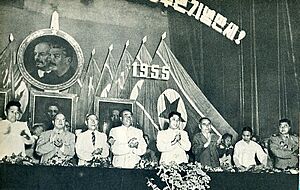
Kim Il Sung slowly gained more and more power. Before this, North Korean politics had four main groups: those who returned from China, ethnic Koreans from the USSR, native Korean Communists, and Kim's own group who had fought against Japan.
Pak Hon-yong, a party leader and Foreign Minister, was blamed for the South Korean people not supporting North Korea during the war. He was removed from his jobs in 1953 and executed after a public trial in 1955.
By 1956, most members of other groups had lost their important positions. More than half of the new leaders had joined after 1950, were under 40, and had little formal education.
In February 1956, Soviet leader Nikita Khrushchev strongly criticized Stalin. This shocked the Communist world. Encouraged by this, some North Korean leaders began to criticize Kim's strong leadership, his growing personality cult, and his economic plans. Kim then removed them from power in an event called the August Faction Incident. By 1960, 70% of the leaders from 1956 were no longer in politics.
Kim's personality cult was based on Stalin's. After Stalin's death in 1953, Kim was called the "Great Leader" or "Suryong." As his personality cult grew, the idea of Juche (self-reliance) became more important than Marxism–Leninism. The cult also included his family, creating a "revolutionary bloodline." In 1972, to celebrate Kim Il-sung's birthday, the Mansu Hill Grand Monument was unveiled, which included a 22-meter bronze statue of him.
International Relations
Like Mao in China, Kim Il Sung did not accept Khrushchev's criticism of Stalin and continued to run his country like Stalin did. At the same time, he increasingly emphasized Korea's independence, using the idea of Juche. Kim told a Soviet leader in 1965 that he was not anyone's puppet and that North Korea followed "the purest Marxism."
Relations with China had become worse during the war. Mao Zedong criticized Kim for being a poor military commander.
By the late 1950s, North Korea and China began to talk about their border. This led to a treaty in 1962 that set the modern border between the two countries.
Tensions between North and South Korea grew in the late 1960s with small armed clashes. In 1966, Kim said "liberation of the south" was a "national duty." In 1968, North Korean commandos tried to kill the South Korean President Park Chung Hee. Soon after, the US spy ship Pueblo was captured by the North Korean navy. The crew was held captive for a year, even though the US said the ship was in international waters. They were released after the US issued a formal apology. In April 1969, a North Korean jet shot down a US spy plane, killing all 31 crewmen. The US government couldn't react strongly because it was busy with the Vietnam War. However, the Soviet Union did not approve of these actions, as they didn't want another big war in Asia.
After Khrushchev was replaced by Leonid Brezhnev as Soviet leader in 1964, North Korea strengthened its ties with the USSR, encouraged by Soviet aid. Kim criticized China's Cultural Revolution as "unbelievable idiocy." In return, China's Red Guards called him a "fat revisionist."
In 1972, the first official meeting between Pyongyang and Seoul took place. But these careful talks did not lead to a lasting change in their relationship.
When South Vietnam fell in 1975, Kim Il Sung felt that the US was weak and that he could unite Korea under his rule. Kim visited Beijing in May 1975 hoping to get support for another invasion of South Korea, but Mao Zedong refused. Mao privately told Kim that China couldn't help because of problems from the Cultural Revolution and because China had recently decided to restore relations with the US.
Meanwhile, North Korea showed its independent path by joining the Non-Aligned Movement in 1975. It promoted Juche as a model for developing countries. It built strong ties with leaders in countries like the Central African Republic, Equatorial Guinea, Uganda, Libya, and Romania.
Economic Growth
North Korea was rebuilt after the war with a lot of help from China and the Soviet Union. Koreans who had worked in Japanese industries also played a big part. Farmland was gathered into collective farms between 1953 and 1958. Many landowners had been removed earlier or during the war.
Recovery from the war was slowed by a huge famine in 1954–55. Local officials had lied about how much food was harvested. After the government took its share, many farmers faced starvation; about 800,000 people died. Also, many farmers resisted collective farming; some killed their livestock rather than give them to the collective.
North Korea, like other Communist countries after the war, invested a lot in heavy industry, public services, and military strength. They didn't focus much on making goods for people to buy.
The first Three-Year Plan (1954–1956) introduced the idea of Juche or self-reliance. The first Five-Year Plan (1957-1961) completed the collective farming and started big campaigns like the Chollima Movement to boost production. Industry was fully state-owned by 1959. Taxes on farm income were removed in 1966.
North Korea was put on a "semi-war footing," meaning equal importance was given to both the civilian economy and the military. This was shown by the slogan, "Arms in one hand and a hammer and sickle in the other!"
On the ruins left by the war, North Korea built an industrialized economy controlled by the government. The country tried to develop strong trade with countries in the Third World. Che Guevara, a Cuban government minister, visited North Korea in 1960 and said it was a model for Cuba. In 1965, a British economist called North Korea's economic growth a "miracle." As late as the 1970s, its economic output per person was thought to be similar to South Korea's. By 1968, all homes had electricity, though the supply was not always steady. By 1972, all children from age 5 to 16 were in school, and over 200 universities and colleges had been built. By the early 1980s, most of the population lived in cities.
Kim Il-sung's Later Years (1970s–1994)
In the 1970s, North Korea's economy stopped growing, and living standards stopped improving. This was made worse by a decision to borrow money from other countries and invest heavily in military industries. North Korea wanted to rely less on aid from China and the Soviet Union, which led to increasing its military power. The government thought it could pay for these costs by borrowing money and selling its minerals on the international market. North Korea invested a lot in its mining industries and bought many mining machines and factories from developed capitalist countries.
However, after the 1973 oil crisis, international prices for many of North Korea's minerals fell. This left the country with huge debts that it couldn't pay back, while still trying to provide good social welfare for its people. North Korea started to miss debt payments in 1974 and stopped almost all repayments by 1985. Because of this, it couldn't pay for new foreign technology.
By the mid to late 1970s, some capitalist countries, including South Korea, were creating new industries based on computers, electronics, and other advanced technology. This was very different from North Korea's economy, which focused on mining and steel production. People also stopped moving to cities as much.
In October 1980, Kim Jong Il was introduced to the public as the person who would take over from Kim Il Sung. In 1972, Kim Jong Il had shown himself to be a leading thinker with his book On the Juche Idea. In 1974, he was officially confirmed as his father's successor.
In 1983, North Korea carried out the Rangoon bombing, a failed attempt to kill South Korean President Chun Doo-hwan during his visit to Burma. This attack on neutral ground made many Third World countries rethink their diplomatic ties with North Korea.
In 1984, Kim Il Sung visited Moscow during a big tour of the USSR, where he met Soviet leader Konstantin Chernenko. Kim also visited East Germany, Czechoslovakia, Poland, Hungary, Romania, Bulgaria, and Yugoslavia. Soviet involvement in North Korea's economy grew until 1988. In 1986, Kim met the new Soviet leader Mikhail Gorbachev in Moscow and received a promise of support.
The bombing of Korean Air Flight 858 in 1987, before the Seoul Olympics, led the US government to put North Korea on its list of terrorist countries.
Despite growing economic problems, the government spent a lot of money on impressive projects, like the Juche Tower, the Nampo Dam, and the Ryugyong Hotel. In 1989, as a response to the 1988 Seoul Olympics, North Korea held the 13th World Festival of Youth and Students in Pyongyang. The grand style of the government and its personality cult, seen in monuments and events, has been seen as a reason for the economic decline.
However, Gorbachev's reforms, China's economic reforms starting in 1979, and the collapse of the Eastern Bloc from 1989 to 1991 made North Korea more isolated. The leaders in Pyongyang said that the fall of the Eastern Bloc Communist governments proved that their Juche policy was correct.
The collapse of the Soviet Union in 1991 meant North Korea lost its main source of economic aid. China became the isolated country's only major ally. Without Soviet aid, North Korea's economy fell sharply. By the early 1990s, Kim Jong Il was already managing most of the daily running of the state. He was made Supreme Commander of the Korean People's Army in December 1991 and Chairman of the National Defence Commission in 1993. Meanwhile, international tensions grew over North Korea's efforts to develop nuclear weapons. Former US president Jimmy Carter visited Pyongyang in June 1994, met with Kim, and returned saying he had resolved the crisis.
Kim Jong-il's Time (1994–2011)
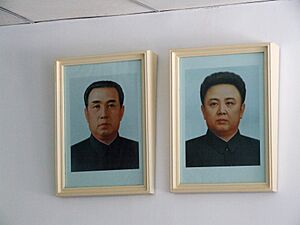
Kim Il Sung died suddenly from a heart attack on July 8, 1994. The politics in Kim Il Sung's last years were very similar to the beginning of Kim Jong Il's time as leader.
As early as 1990, the economy started to decline sharply. From 1990 to 1995, foreign trade was cut in half, and the loss of cheap Soviet oil was especially hard. The crisis became very serious in 1995 with widespread flooding that destroyed crops and buildings, leading to a famine that lasted until 1998. At the same time, there seemed to be little strong opposition to the government inside the country. Many North Koreans who fled to China because of the famine still showed support for the government and pride in their homeland. Many of these people reportedly returned to North Korea after earning enough money.
In September 1998, Kim Il Sung was declared "eternal President of the Republic," and the office of the presidency was removed. This change showed North Korea's unique characteristic of being a state based on the personality cult around Kim Il Sung, giving leaders titles with power even after they died. The jobs and powers that belonged to the President were divided among three officials: the head of government (the Premier), the head of state (the Chairman of the Supreme People's Assembly), and the head of the military (the Chairman of the National Defence Commission and Supreme Commander of the Korean People's Army). Kim Jong Il used his military positions to increase his power. After the fall of global Communism in the early 1990s and the ongoing economic crisis and famine, North Korea was in a very difficult international situation.
In 1998, the government announced a new policy called "Songun", or "Military First." This policy gives great importance to military matters and makes the Korean People's Army (KPA) the main force in building and developing the country.
After his election in 1998, South Korean President Kim Dae-jung tried to reduce tensions between the two Koreas with his Sunshine Policy. But after George W. Bush became US President in 2000, North Korea faced new pressure over its nuclear program. On October 9, 2006, North Korea announced that it had successfully tested a nuclear bomb underground. North Korea was also developing long-range missiles.
On February 13, 2007, North Korea signed an agreement with South Korea, the United States, Russia, China, and Japan. This agreement said North Korea would shut down its Yongbyon nuclear reactor in exchange for economic and energy help. However, in 2009, North Korea continued its nuclear test program.
In 2010, the sinking of a South Korean naval ship, the Cheonan, allegedly by a North Korean torpedo, and North Korea's shelling of Yeonpyeong Island increased tensions between North and South.
Kim Jong-un's Time (2011–Present)
Kim Jong Il died on December 17, 2011, and his son, Kim Jong Un, became the new leader. In late 2013, Kim Jong Un's uncle Jang Song-thaek was arrested and executed after a trial. According to the South Korean spy agency, Kim may have removed about 300 people from power after taking over. In 2014, a United Nations report accused the government of serious human rights abuses.
In 2015, North Korea adopted Pyongyang Standard Time (UTC+08.30), changing its time zone back from Japan Standard Time (UTC+9.00), which had been set by Japan when it ruled Korea. As a result, North Korea was in a different time zone from South Korea. In 2016, the 7th Congress of the Workers' Party of Korea was held in Pyongyang, the first party congress since 1980.
In May 2016, North Korea held the Seventh Congress of the Workers' Party, the first such meeting in over 35 years. They announced a five-year national economic development plan, the first mid-term economic plan in 24 years.
In 2017, North Korea tested the Hwasong-15, a long-range missile capable of reaching anywhere in the United States. Estimates of North Korea's nuclear weapons at that time ranged from 15 to 60 bombs, possibly including hydrogen bombs.
In February 2018, North Korea sent a high-level group to the Winter Olympics in South Korea. This group included Kim Yo-jong, Kim Jong Un's sister, and President Kim Yong-nam. They invited South Korean President Moon to visit the North. In April, the two Korean leaders met at the Joint Security Area. They announced their governments would work towards removing nuclear weapons from the Korean Peninsula and making peace between the two states. North Korea also said it would change its time zone to match the South. This change happened in May 2018.
On June 12, 2018, Kim met American President Donald Trump at a summit in Singapore and signed a statement, again promising to work for peace and denuclearization. Trump announced he would stop military exercises with South Korea and hinted at removing American troops entirely. In September, South Korean President Moon visited Pyongyang for a summit with Kim. In February 2019 in Hanoi, a second summit between Kim and Trump ended without an agreement. On June 30, 2019, Trump, Moon, and Kim met at the DMZ. Talks in Stockholm began in October between US and North Korean teams but broke down after one day.
Starting in January 2020, the North Korean government took strong steps to stop the spread of the COVID-19 pandemic, including quarantines and travel limits. In April, a US analysis website said this seemed to have been successful.
The 8th Congress of the Workers' Party of Korea, held in early January 2021, brought back the active role of the General Secretary of the Workers' Party of Korea. This title had been given "eternally" to Kim Jong Il in 2012. Kim Jong Un was elected to this position.
|
See also
 In Spanish: Historia de Corea del Norte para niños
In Spanish: Historia de Corea del Norte para niños
- History of Asia
- History of East Asia
- History of Korea
- Prehistoric Korea
- Supreme Leader (North Korean title)
- Politics of North Korea
- Korean conflict


